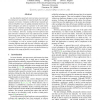Free Online Productivity Tools
i2Speak
i2Symbol
i2OCR
iTex2Img
iWeb2Print
iWeb2Shot
i2Type
iPdf2Split
iPdf2Merge
i2Bopomofo
i2Arabic
i2Style
i2Image
i2PDF
iLatex2Rtf
Sci2ools
DSN
2006
IEEE
2006
IEEE
Automatic Instruction-Level Software-Only Recovery
As chip densities and clock rates increase, processors are becoming more susceptible to transient faults that can affect program correctness. Computer architects have typically addressed reliability issues by adding redundant hardware, but these techniques are often too expensive to be used widely. Software-only reliability techniques have shown promise in their ability to protect against soft-errors without any hardware overhead. However, existing low-level software-only fault tolerance techniques have only addressed the problem of detecting faults, leaving recovery largely unaddressed. In this paper, we present the concept, implementation, and evaluation of automatic, instruction-level, software-only recovery techniques, as well as various specific techniques representing different trade-offs between reliability and performance. Our evaluation shows that these techniques fulfill the promises of instruction-level, software-only fault tolerance by offering a wide range of flexible ...
Computer Networks | DSN 2006 | Low-level Software-only Fault | Software-only Fault Tolerance | Software-only Recovery Techniques |
| Added | 11 Jun 2010 |
| Updated | 11 Jun 2010 |
| Type | Conference |
| Year | 2006 |
| Where | DSN |
| Authors | Jonathan Chang, George A. Reis, David I. August |
Comments (0)

